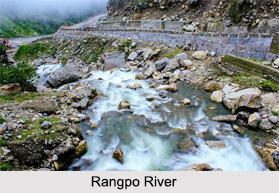 Rangpo River is an Indian River flowing in the state of Sikkim. A tributary of the Teesta River, it is fed by the Rangpo Chu. The town of Rangpo in Sikkim lies on its north bank. The river forms the border between Sikkim and West Bengal states at Rangpo town.
Rangpo River is an Indian River flowing in the state of Sikkim. A tributary of the Teesta River, it is fed by the Rangpo Chu. The town of Rangpo in Sikkim lies on its north bank. The river forms the border between Sikkim and West Bengal states at Rangpo town.
Course of Rangpo River
Rangpo River runs through most of East Sikkim and a few parts of the Darjeeling District of North Bengal. This tributary flows mainly from east to west with a variable channel pattern including braided, meandering, straight, gorge and blocked lake. Its confluence with Teesta River is immediately downstream of Rangpo town.
This article is a stub. You can enrich by adding more information to it. Send your Write Up to content@indianetzone.com.















